The Comprehensive Guide to Singing Bowls: History, Craftsmanship, and Practical Insights
Introduction to Singing Bowls
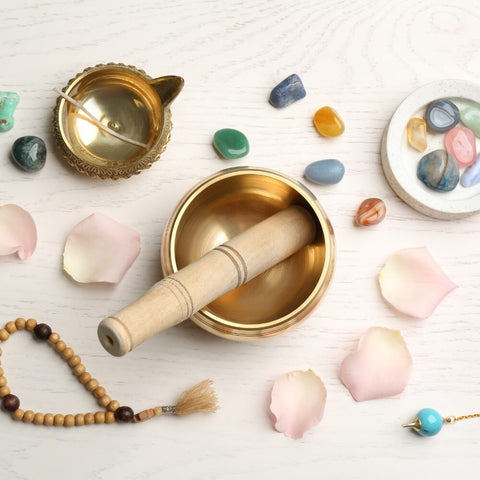
Understanding Singing Bowls: An Overview
Singing bowls, particularly known as Tibetan singing bowls, are fascinating musical instruments that have captivated people with their soothing tones for centuries. When you gently strike the edge with a mallet and move it around the rim, the bowl vibrates and produces calming sounds and music. These unique sounds, each varying with the size and material of the bowl, are believed to promote relaxation and can contribute to healing due to their vibrations. Commonly crafted from metals like bronze or brass, Tibetan singing bowls are found in a variety of shapes and sizes, each offering a distinct sound.
The Tibetan Roots of Singing Bowls
Originating in the Himalayas, specifically Tibet, Tibetan singing bowls have been an integral part of Buddhist rituals and daily practices. Buddhist monks and spiritual practitioners have historically used them to deepen their meditation and prayer experiences, leveraging the bowls' ability to aid in achieving a focused and tranquil state.
The centuries-old crafting process in Tibet often involves the meticulous hand-mixing of metals, with bronze—a copper and tin alloy—being the traditional choice. In recent times, brass Tibetan singing bowls have gained popularity for their bright luster and robust sound, reflecting both the evolution of crafting techniques and changes in material availability. These handcrafted bowls, each with a unique timbre, are not merely instruments but revered tools for peace and introspection.
Having transcended their Himalayan origins, Tibetan singing bowls have become a global symbol for wellness and serenity. Cherished in homes, wellness centers, and spaces dedicated to tranquility worldwide, they embody a universal appeal that crosses cultural boundaries.
They serve a wide array of purposes—from personal meditation and group sessions to simply enjoying their harmonious music. In this way, Tibetan singing bowls continue to be a versatile and significant presence in various practices around the world.
The Rich History of Singing Bowls
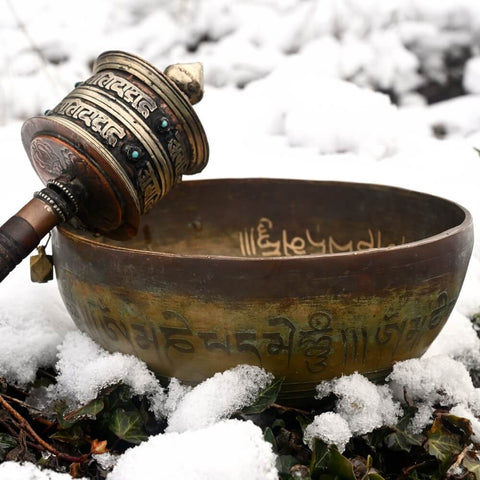
The Ancient Origins and Journey Through Time
Tibetan singing bowls hold a rich history that dates back thousands of years. While they are commonly associated with Tibetan spiritual practices, their use is not limited to Tibet. Historical evidence suggests that similar types of metal bowls were utilized in various cultures throughout Asia, including Nepal, India, and Bhutan. They played a significant role in religious and spiritual ceremonies, often being used to accompany meditations and prayers.
Over time, the secret of the singing bowls spread from the quiet mountain temples to the rest of the world. Travelers who visited Asia saw these bowls and wanted to learn more about them. They discovered that these bowls weren’t just for music; they were also used to make people feel better, both in their bodies and in their minds. This blend of spiritual utility and therapeutic benefit has contributed to the widespread appeal of singing bowls, transcending cultural and geographical boundaries.
Singing Bowls in Various Cultures
As singing bowls traveled the world, they were welcomed into new cultures. Each place added its own touch to how the bowls were used. In some settings, they are utilized by individuals seeking quiet reflection and deep thought.
Singing bowls became popular in the West during the 1970s. People looking for new ways to relax and find peace started using these bowls. They also found a place in music, with some musicians using them to create new and different sounds.
What's really interesting is that even though singing bowls are used in many cultures, they all understand the bowls’ power to help people feel calm and peaceful. Whether it's during a busy day or in a quiet place for thinking, singing bowls have a special way of touching people's hearts with their gentle music.
The Art of Making Singing Bowls

Traditional Methods of Crafting Bronze Bowls
Crafting bronze singing bowls is an age-old tradition, deeply rooted in skill and heritage. Bronze, a durable alloy of copper and tin, is favored for its ability to produce rich, resonant sounds. The creation of a bronze singing bowl begins with a flat, circular piece of bronze. Artisans, often with knowledge passed down through generations, heat this metal to make it malleable. The shaping of the bowl is a hands-on process, involving a meticulous sequence of hammering while the metal is hot. Each strike not only shapes the bowl but also contributes to the unique sound it will eventually produce. This traditional hammering technique is crucial for achieving the bowl's final form and acoustic properties.
Crafting Process for Brass Singing Bowls
Brass singing bowls, on the other hand, are commonly made through casting. In this method, molten brass—an alloy of copper and zinc known for its bright, golden appearance—is poured into pre-made molds. Once the brass cools and solidifies, the rough bowl is removed from the mold. This bowl then undergoes a series of finishing steps, including smoothing, polishing, and sometimes engraving with intricate designs. Though casting is a more modern and less labor-intensive method than hammering, it still requires a significant level of skill to ensure the bowl has the right shape, thickness, and surface to produce beautiful sounds.
The Journey from Metal to Music
Regardless of the method, the transformation of metal into a singing bowl is a remarkable journey. After the initial shaping, whether hammered or cast, the bowl is carefully tuned. Artisans strike the bowl and listen to its sound, making fine adjustments to achieve the perfect tone. This tuning process is as much an art as it is a science, requiring a keen ear and deep understanding of sound, especially when crafting bowls like the 7 chakra singing bowls, which are tuned to specific frequencies that correspond to the body’s energy centers.
The final step in the bowl's creation involves finishing touches such as polishing and decorating. These decorations can range from simple etchings to elaborate motifs that often hold spiritual or cultural significance, including symbols related to the 7 chakras. Once complete, the singing bowl is ready to serve its purpose, whether for meditation, healing, or as a musical instrument, carrying with it the rich tradition and meticulous craftsmanship of its maker.
Types of Singing Bowls
Singing bowls come in different types, each with its own unique sound and beauty. Let's explore some of these types:
Bronze Singing Bowls: A Classic Choice
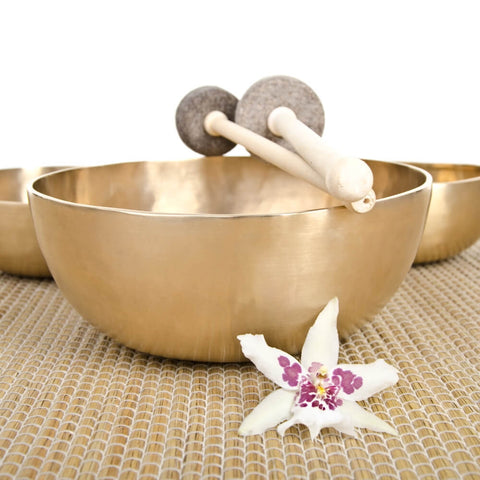
Hand-hammered bronze singing bowls are the traditional choice. They are made from an alloy of copper and tin, which is called bronze. This mix has been used for thousands of years to make musical instruments. Bronze bowls are loved for their deep and rich sounds. Each hit and circle of the mallet around the bowl's edge brings out a warm and long-lasting tone that many people find very calming. These bowls are often used in meditation and healing practices because of their soothing sounds.
Brass Singing Bowls: The Contemporary Melody
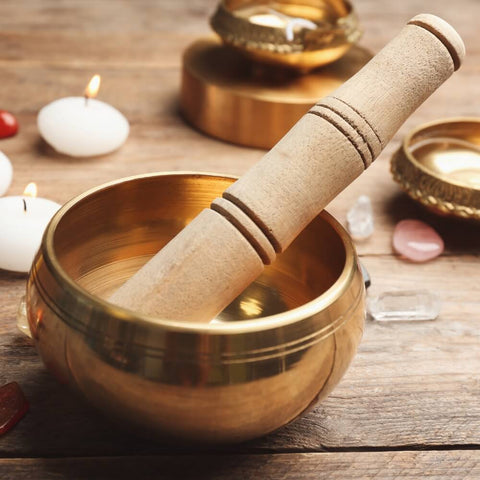
Handcrafted brass singing bowls, considered more modern due to their bright and clear sound, have become popular. Brass, a mix of copper and zinc, gives these bowls a shiny, golden look that catches the eye. These bowls are popular for their beauty and their uplifting tones, making them suitable for lighter, more cheerful kinds of meditation and music.
Exploring Other Materials and Styles
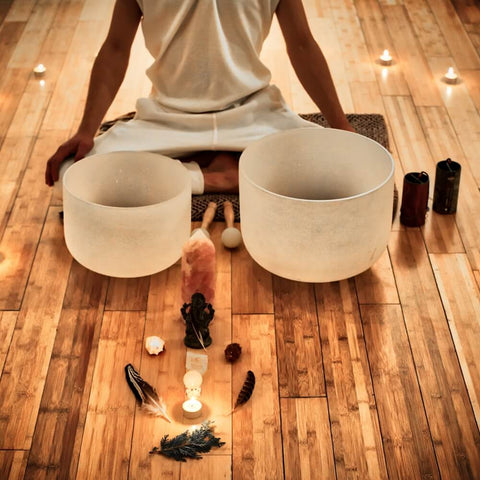
Besides bronze and brass, there are also singing bowls made from other materials. Some are made from crystal, known for producing a very clear and high-pitched sound, often used in practices that require very precise sound frequencies.
There are also bowls that mix different metals, like gold and silver. These special bowls have a wide range of sounds and are often considered very special and powerful.
Each type of singing bowl, with its unique material and style, offers a different experience. Whether you prefer the deep and resonant tones of bronze, the bright sounds of brass, or the crystal clarity of other materials, there's a singing bowl that's perfect for your needs.
Learning to Play Singing Bowls
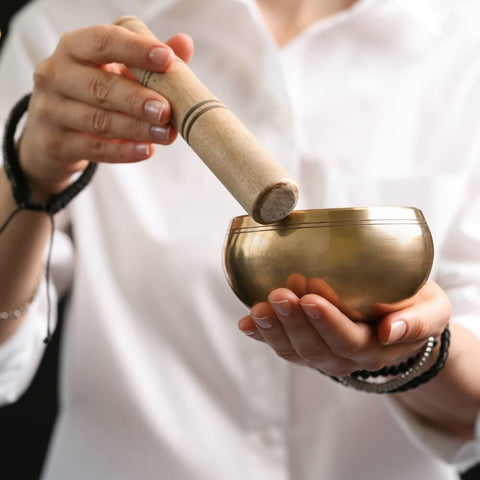
Playing singing bowls is like learning to speak a new language, one that speaks directly to the heart and soul through sound. Here’s how you can start:
Basic Techniques for Beginners
1. Holding the Bowl: Start by placing the singing bowl on your open palm. Make sure your hand is flat so the bowl doesn't touch your fingers too much. This way, the bowl can vibrate freely and make the best sound.
2. Using the Mallet: Take the mallet (the stick used to play the bowl) in your other hand. Hold it like a pen, but with a relaxed grip. This will help you control the mallet better.
3. Striking the Bowl: Gently tap the side of the bowl with the mallet. This should make a nice, ringing sound. It's like saying "hello" to the bowl and starting your conversation with it.
4. Making the Bowl Sing: After striking the bowl, you can make it "sing" by moving the mallet around the edge of the bowl. Keep a firm but gentle pressure and a steady pace. You'll start to hear a beautiful, continuous sound that grows louder.
Tips for Creating Harmonious Sounds
1. Find Your Pace: Every bowl sings best at a certain speed. If your bowl isn't singing, try moving the mallet faster or slower until you find the right pace.
2. The Right Pressure: Applying the correct amount of pressure is key. Too much pressure can make the sound harsh, while too little won't activate the singing. Start light, then gradually press harder until you find the sweet spot.
3. Listen and Adjust: Playing the singing bowl is all about listening. If the sound feels off, adjust your grip, pressure, or speed. Each bowl is unique, so what works for one might not work for another.
4. Stay Relaxed: Keep your movements smooth and your body relaxed. Tension, especially in your hand and arm, can affect the sound. If you're relaxed, the bowl will be more likely to produce a clear and beautiful tone.
5. Practice Regularly: Like any skill, playing singing bowls gets better with practice. Spend time experimenting with your bowl, and you'll soon find that you can bring out its best sounds effortlessly.
Remember, playing singing bowls is not just about technique; it's about feeling and connection. Let yourself be absorbed by the sounds and vibrations, and enjoy the peaceful journey they take you on.
The Therapeutic Power of Singing Bowls
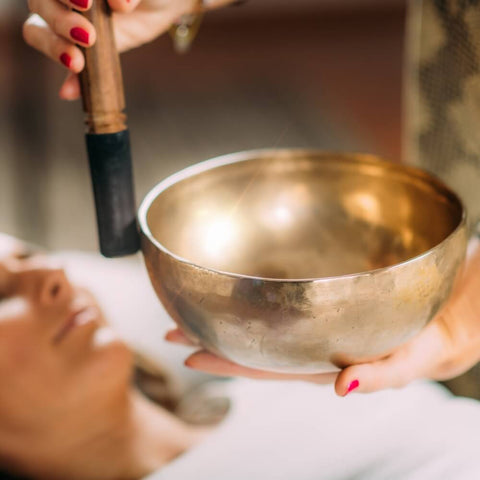
The therapeutic power of singing bowls extends beyond their musical charm, offering a range of benefits for healing and relaxation. The key lies in the frequency of the sound waves produced by these bowls, which can resonate with the body's own vibrations to promote a deep sense of calm. In this section, we'll delve deeper into the science behind these sound frequencies and explore how singing bowls can be used effectively for therapy and meditation.
The Science of Sound Healing
Sound healing is based on the idea that everything, including our own bodies, is made up of vibrations. When something isn't right in our body or mind, it's like we're out of tune. The vibrations from singing bowls can help bring us back into harmony.
When you play a singing bowl, it creates sound waves that spread out in all directions. These sound waves are a type of energy that can travel through the air and into our bodies. Scientists have found that certain sounds can reduce stress, slow down our heart rate, and even lower blood pressure. This is because calming sounds can activate the part of our nervous system that helps us relax.
Using Singing Bowls for Meditation and Therapy
1. Meditation: Singing bowls are perfect for meditation because their sounds help clear our minds. When you focus on the sound of a singing bowl, it's easier to let go of busy thoughts and just be in the moment. This can make your meditation deeper and more peaceful.
2. Relaxation and Stress Relief: Playing a singing bowl or listening to its sounds can be very relaxing. It's a great way to unwind after a long day or to calm down when you're feeling stressed. The gentle vibrations can help release tension in your body and make you feel more at ease.
3. Healing and Therapy: Some people use singing bowls as part of therapy. The idea is that the sound vibrations can help the body and mind heal themselves. For example, playing a singing bowl might help someone feel less anxious or help with pain relief.
4. Yoga and Bodywork: Singing bowls are also used in yoga classes and during massages or other bodywork. The sound helps create a soothing environment, making it easier to stretch, relax, and connect with your body.
Using singing bowls is all about exploring what works best for you. Whether you're playing the bowl yourself or listening to someone else, the key is to be open and let the sounds guide you to a place of balance and peace.
Caring for Your Singing Bowls
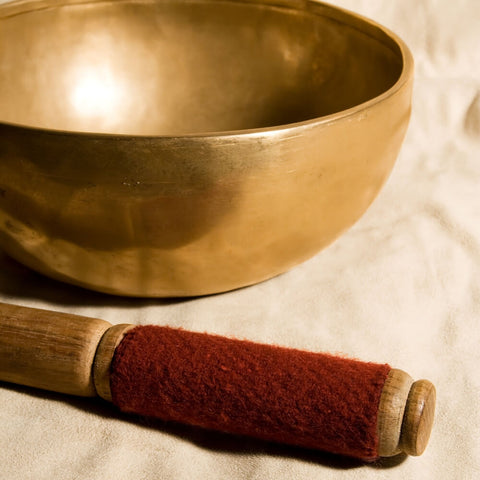
Taking good care of your singing bowls means they'll last a long time and keep sounding beautiful. Here's how you can look after bronze and brass bowls:
Maintenance of Bronze and Brass Bowls
1. Keep It Clean: After you use your singing bowl, give it a quick wipe with a soft, dry cloth. This helps remove any fingerprints or dust. For bronze bowls, you might notice a greenish buildup over time called patina. It's natural, but if you prefer your bowl shiny, you can gently polish it off with a cloth and some metal cleaner. Just be gentle to avoid scratching the bowl.
2. Using Water Wisely: While the traditional approach to maintaining Tibetan singing bowls emphasizes keeping them dry to preserve their integrity, contemporary sound healing practices have embraced the use of water to explore varied sound textures and visual effects. If you choose to incorporate water into your singing bowl practices, opt for clean, distilled water to safeguard the metal. It's crucial to thoroughly dry your bowl after use to prevent any potential damage and maintain its pristine condition.
3. Gentle Polishing: If your bowl loses its shine, you can use a special metal polish for brass or bronze. Always read the instructions, and test a small area first to make sure it doesn't damage the bowl. A little goes a long way, and make sure to remove all the polish after you're done to avoid any residue.
Storing Your Bowls to Preserve Their Beauty and Sound
1. Safe Place: Store your singing bowl in a spot where it won't get knocked over or scratched. A shelf or a padded box can be good choices. If you stack bowls, put a soft cloth between each one to prevent scratches.
2. Avoid Extreme Temperatures: Don't leave your singing bowl in very hot or cold places, like near a heater or in a chilly garage. Extreme temperatures can affect the metal and might change how your bowl sounds.
3. Use a Cushion: Many people like to keep their singing bowl on a little cushion or ring. This isn't just for looks; it also protects the bottom of the bowl from scratches and can help it sound better when you play it.
Taking care of your singing bowls is all about keeping them clean, dry, and safe. With a little bit of attention, your bowls will stay beautiful and sound amazing for many years.
Choosing and Buying Your Singing Bowl

Finding the right singing bowl is a bit like finding a new friend. You'll want one that speaks to you and fits well into your life. Here are some things to think about when picking out your bowl:
Factors to Consider: Sound, Size, and Material
1. Sound: The most important thing about a singing bowl is its sound. Each bowl has its own unique tone. Some might sound deep and warm, while others might be bright and clear. Think about what kind of sound feels soothing to you. If you can, try playing a few bowls to see which one's sound you like best.
2. Size: Singing bowls come in lots of sizes, from small enough to fit in your hand to big enough to fill a room with sound. Bigger bowls usually make lower, deeper sounds, and smaller ones have higher tones. Think about where you'll use your bowl and how you'll play it. If you want to carry it around or have limited space, a smaller bowl might be better.
3. Material: Most singing bowls are made from bronze or brass, but there are also crystal bowls and ones made from other metals. Each material gives the bowl a different look and sound. Bronze bowls are traditional and have rich, complex tones. Brass bowls are bright, both in look and sound. Crystal bowls offer very clear, pure tones.
Ensuring Authenticity: Tips for Buying Genuine Bowls
1. Buy from Reputable Sellers: Whether you're shopping in a store or online, it's important to buy from someone who knows a lot about singing bowls and cares about their quality. They should be able to answer your questions and tell you where the bowls came from.
2. Look for Handmade Signs: Genuine singing bowls are often made by hand, so each one is a little bit different. Look for small irregularities in shape or pattern that show a person made it, not a machine.
3. Listen Carefully: Authentic singing bowls have complex, long-lasting sounds. When you strike the bowl, the tone should build and linger, filling the space with its vibration. If the sound seems flat or ends quickly, the bowl might not be of good quality.
4. Ask Questions: Don't be afraid to ask the seller about the bowl's history, how it was made, and how to play it. A good seller will be happy to share this information with you.
Finding the right singing bowl can take some time, but when you find the one that feels right, you'll know. It will not only be a beautiful object in your home but also a source of peace and calm whenever you need it.
Supporting the Artisans and the Craft
When you buy a singing bowl, you're not just getting a beautiful instrument; you're also becoming part of a long tradition of craftsmanship. Here's why choosing handcrafted bowls matters:
The Importance of Choosing Handcrafted Bowls
1. Quality and Uniqueness: Handcrafted singing bowls are made by skilled artisans who put their care and expertise into every bowl. This means each bowl is unique, with its own sound and character. When you choose a handcrafted bowl, you're getting something special that stands out from mass-produced items.
2. Keeping Traditions Alive: Making singing bowls is a traditional craft passed down through generations. By choosing handcrafted bowls, you're helping to keep these traditions alive. It's a way to honor the history and culture behind the bowls and ensure that the art of making them is not forgotten.
3. Supporting Real People: Buying handcrafted bowls means you're supporting individual artisans and their families. It's a more personal purchase because you know your money is going directly to someone who put their time and talent into making your bowl.
How Your Purchase Helps Preserve a Tradition
1. Economic Support: When you buy a handcrafted singing bowl, you're providing financial support to artisans. This helps them continue their craft and supports their livelihood. It's especially important in places where traditional crafts are one of the few sources of income.
2. Cultural Preservation: Singing bowls are part of the cultural heritage of many regions, especially in Asia. Buying genuine, handcrafted bowls helps ensure that the cultural significance of these bowls is appreciated and preserved.
3. Inspiring Future Artisans: Supporting current artisans also encourages the next generation to learn and continue the craft. When young people see that there's value and appreciation for handcrafted items, they're more likely to take an interest in learning these skills themselves.
By choosing handcrafted singing bowls, whether they're made of brass or bronze, you're doing more than just buying an instrument. You're becoming part of a story that spans generations and continents. You're helping to ensure that the beautiful tradition of making and playing these bowls continues far into the future.
Conclusion: The Universal Language of Singing Bowls
Singing bowls carry a magic that goes beyond words. Their sound touches something deep inside us, connecting us to a sense of peace and calm that's hard to find in our busy world. Let's wrap up what makes these instruments so special.
The Timeless Appeal of These Instruments
Singing bowls have been around for centuries, and their appeal hasn't faded. Why? Because their sound is timeless. It doesn't matter where you're from or what language you speak; the sound of a singing bowl can speak to your heart. These bowls bring us back to a simpler, more peaceful state of mind, reminding us of the beauty of the present moment.
Their appeal also lies in their simplicity. In a world full of complex gadgets and technology, the singing bowl remains a simple, yet profound tool for relaxation and meditation. Its single, resonant tone invites us to slow down and breathe, offering a haven from the hustle and bustle of everyday life.
Inviting You to Experience Their Unique Sound
If you've never tried playing a singing bowl, you're in for a treat. The experience is unique and can be deeply personal. The vibrations and sounds of the bowl can help you find a moment of peace, make your meditation deeper, or simply bring a beautiful sound into your home.
We encourage you to explore the world of singing bowls. Whether you're drawn to the craftsmanship of a hand-hammered Tibetan bronze singing bowl, the bright tones of a handcrafted brass singing bowl, or the clarity of a crystal one, there's a singing bowl out there that will resonate with you. And when you find it, let its sound wash over you and take you to a place of peace and calm.
Singing bowls are more than just musical instruments; they're tools for well-being, gateways to meditation, and keepers of tradition. Their universal language of vibration and sound is there for all to hear, inviting us to listen, relax, and connect with something deeper within ourselves and the world around us.
FAQs: Answers to Common Questions About Singing Bowls
Q: Why are they called Tibetan singing bowls?
A: They're often called Tibetan singing bowls due to their strong historical association with Tibetan Buddhist practices. However, their use extends across the Himalayan region, reflecting a rich tapestry of cultural traditions.
Q: What are singing bowls used for?
A: Singing bowls are used for many things like meditation, relaxation, and even some kinds of healing and therapy. People also use them just to enjoy their beautiful sounds.
Q: Can anyone learn to play a singing bowl?
A: Yes, absolutely! You don't need any special skills to start. With a little practice, anyone can learn to make a singing bowl sing.
Q: How do I pick the right singing bowl for me?
A: When selecting a singing bowl, consider the size and material, as these affect the tone and resonance. Look for detailed descriptions and customer reviews to understand each bowl's unique sound and quality, ensuring it meets your needs for meditation, therapy, or decoration.
Q: Are bigger bowls better than smaller ones?
A: Not necessarily. Bigger bowls produce deeper sounds, and smaller bowls have higher-pitched sounds. It all depends on what kind of sound you prefer.
Q: How do I take care of my singing bowl?
A: To take care of your singing bowl, regularly wipe it with a soft, dry cloth to remove fingerprints and dust. If you use water in your bowl for sound effects, be sure to use distilled water and dry the bowl thoroughly afterwards to prevent tarnishing. When not in use, store your bowl in a safe place—like on a cushion or in a padded box—where it won't get knocked over or scratched. Keep it away from extreme temperatures to maintain the bowl's quality and sound.
Q: Is it okay to buy a singing bowl online?
A: Yes, you can find good quality singing bowls online. Just make sure to buy from a reputable seller who provides clear information about the bowls.
Q: How often should I play my singing bowl?
A: As often as you like! Some people play their bowls every day as part of their meditation or relaxation routine, while others play them whenever they feel the need.
Q: Can singing bowls heal medical conditions?
A: While singing bowls can be very relaxing and reduce stress, they're not a replacement for medical treatment. However, many people find them helpful for improving their overall well-being.
Remember, there's no right or wrong way to enjoy your singing bowl. Whether you're using it for meditation, relaxation, or simply as a beautiful musical instrument, the most important thing is that it brings you joy and peace.



Leave a comment